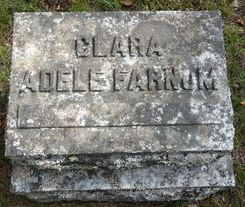#24 A FAMILY--ALL ACTORS..Part 1--THE PARENTS
THE THEATRICAL FARNUMS--THE PARENTS
A family of actors! I cannot imagine dinnertime around the Methuen, Massachusetts table when the Farnums were all vying for the spotlight. Greenleaf Farnum, father, was an actor, director and agent; Mother Clara was a singer. All three sons--Dustin, William and Marshall-- became theatre and film actors and two of them have stars on Hollywood's Walk of Fame.
CLARA ATWELL FARNUM--MATRIARCH
Clara
performed under the stage name of Adele LaGros and for many years was an
operatic prima donna, especially well-known with the New Orleans Stock American
Comic Opera Company. She lost her voice from diphtheria and retired for seven
years but returned to the stage in dramatic work.
GREENLEAF DUSTIN FARNUM--PATRIARCH
Greenleaf was born June 1848 in New Hampshire to Greenleaf Boles Farnum and Martha Ann Webster. The family moved to Boston where his father died in 1856 and his mother soon remarried.
The US Civil war began in April 1861 when Confederate Troops fired on Fort Sumpter, South Carolina. In 1863, the US Congress approved conscription; northern states also approved paying bounties, cash awards paid to men who volunteered to serve in some new regiments. In 1863, eight companies of heavy artillery were recruited for use guarding the forts along the Massachusetts coast. In January 1864, Greenleaf enlisted in the 3rd Regiment, Massachusetts Heavy Artillery.
In the spring of 1864, Farnum and his company were transferred to Washington where they were assigned to guard the capital, thus releasing more experienced soldiers to go to the front. When Farnum volunteered it was on the understanding that he would only be assigned to garrison duty in Massachusetts; hence there was a lot of dissatisfaction when the regiment was transferred to the defense of Washington. Private Farnum was assigned to Company “I”, recruited from mechanics and was assigned as an engineer corps; this company was placed in charge of the army’s pontoons over the James River. They built pontoon bridges across the Appomattox River, built the pontoon bridge used in the pursuit of General Lee’s fleeing army, built the bridge at Richmond used by the Union Army on their way back to Washington at the end of the war. In addition, Company “I” captured saw mills, built wharves and roads and performed general engineer duty.
1865 Pontoon bridge over Appomattox
Broadway Landing
A bullet forceps, used to extract bullets, a crimper for snipping off bits of shattered bone, and a bone saw were the tools most often used by a surgeon after battles. Amputation knives came in a variety of sizes; this enabled the surgeon to remove anything he needed from the tip of a finger to an entire leg.
Greenleaf was mustered out Sept 26, 1865. He returned
to Boston, worked as machinist, and in May 1867 married Lorinda Edwards, aged
18. Five years later (Dec 10 1871), both Lorinda and their baby son Fenton, died in
childbirth. On Mar 27, 1873, Greenleaf married singer-actress Clara Adele Atwood, aged 15. In
the next 5 years, they had four children—Dustin, William, Beatrice and Marshall.
Beatrice died, aged 7, of croup.
Tradition says
that Greenleaf was born in a dressing room and that never during his long life
was he more than a mile away from some theatre. For many years, he was a
well-known singing comedian in comic opera and later appeared on the dramatic
stage. The latter part of the 19th century was the golden age of touring
in American theatre—melodramas, minstrel shows, comedies, farces, circuses,
vaudeville, operas, operetta, musicals. Greenleaf was a theatrical manager for
40 years and his most important clients were Robert Downey, (travelling theatre
company), and J.H.Haverly (promoter of blackface minstrel shows)
Likely
sometime in the 1890s, Greenleaf was “divorced” from Clara (no record found). He
married another actress, Nettie L. Baker, in New Orleans in January 1896. She
was 26, he was 47. She was performing in Downing’s production of “Helena”;
Greenleaf was manager of this theatre company.
Greenleaf retired and was in failing health for some time before his death in Manhattan on February 19, 1912. He was buried in the Milton Cemetery in the Blazo plot alongside his sister, Mary Elizabeth Farnum Blazo (1840-1903).
His second wife, Clara, died in New York City on February 25 1903 from surgical complications and is buried alongside her two sons in Silver Lake Cemetery in Bucksport, Maine.
His third wife, Nettie, married Lieutenant-Colonel Percy Walton (1872-1955) on June 30, 1913 in Chicago. For many years, Nettie was genealogist of her Baker family; she was eligible for membership in the Mayflower Society and as Daughter of the American Revolution. Nettie died March 9, 1948 in New York City and is buried in Arlington National Cemetery alongside her second husband.












Greenleaf sounds like quite the character!
ReplyDeleteVery interesting reading.
ReplyDelete